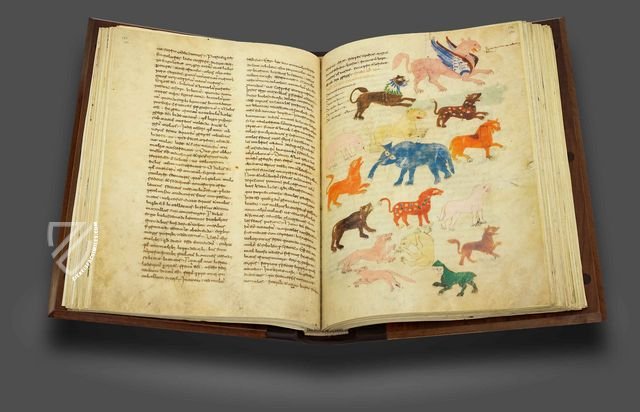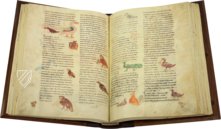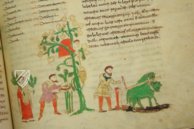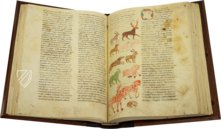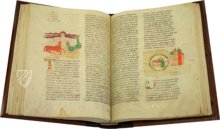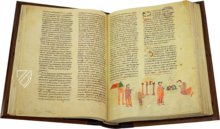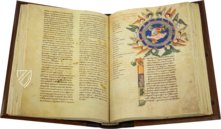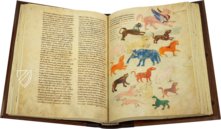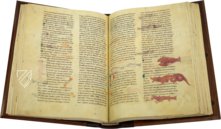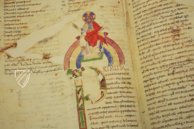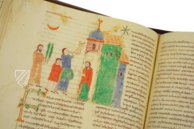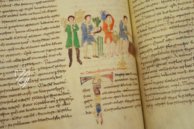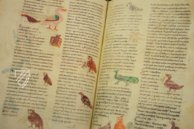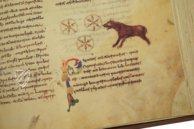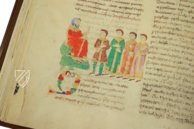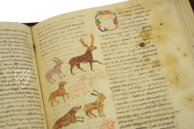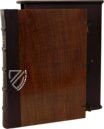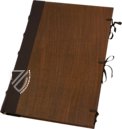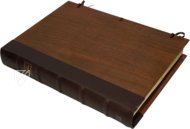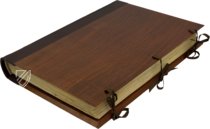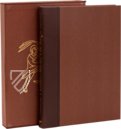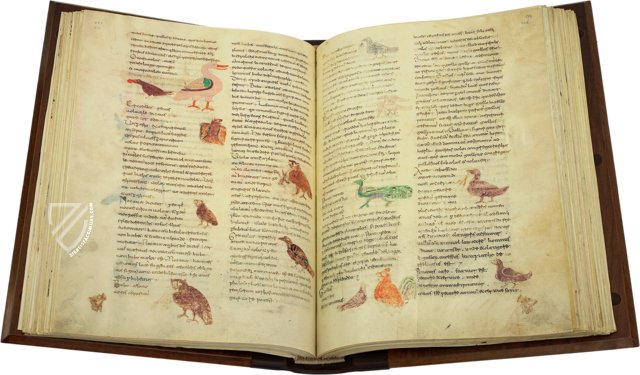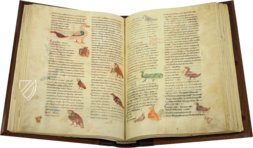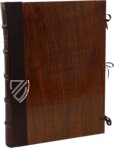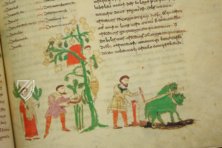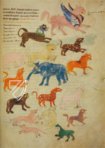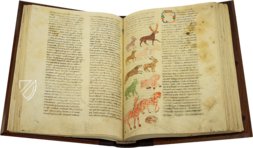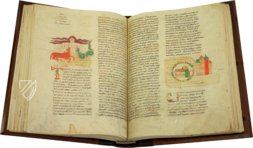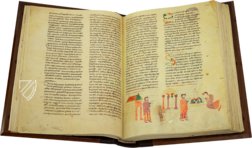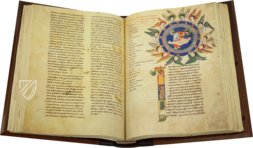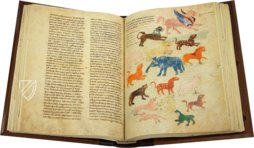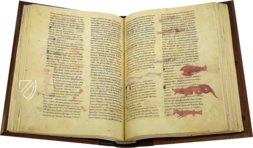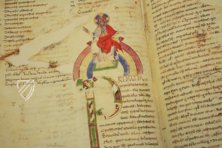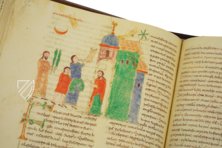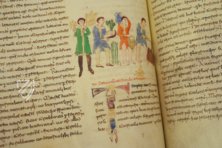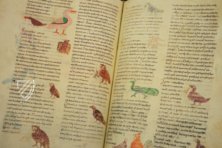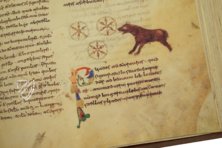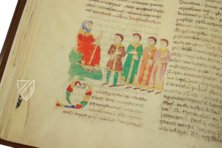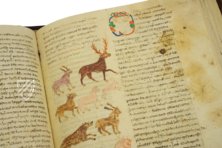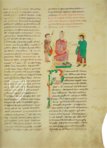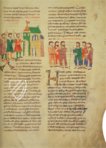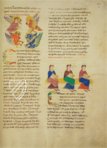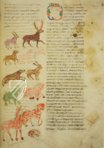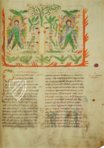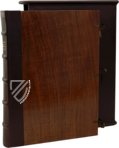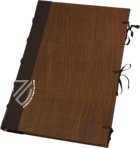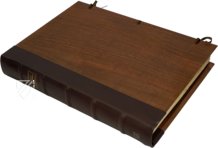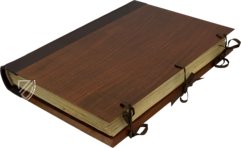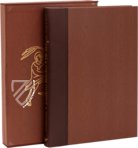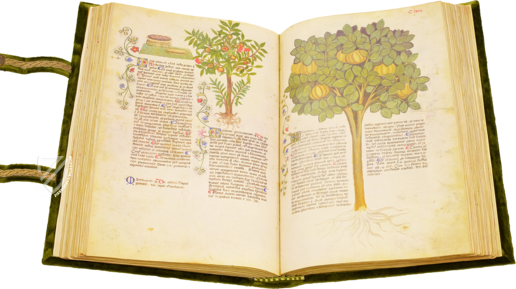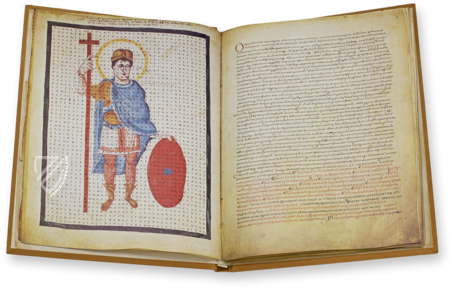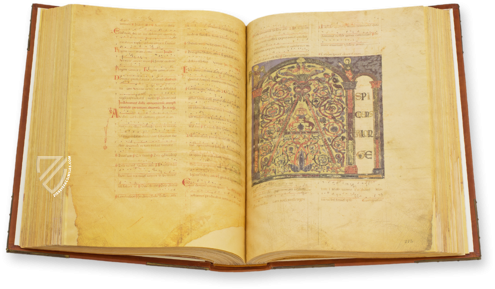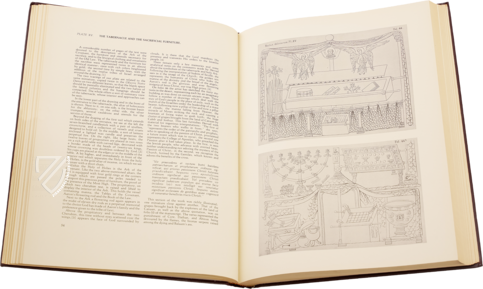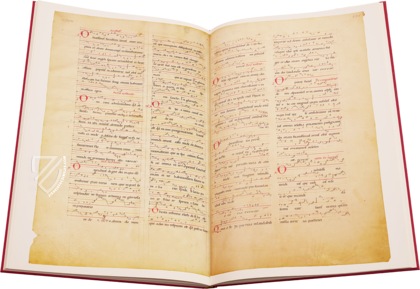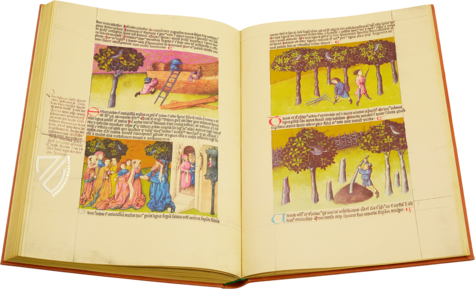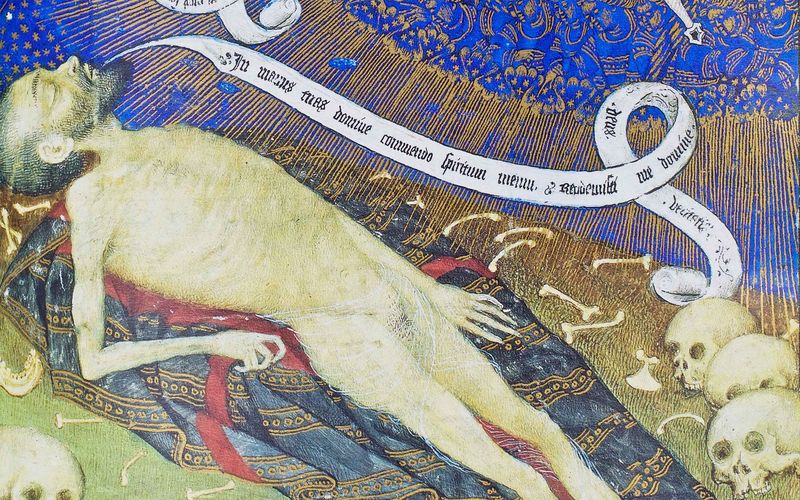Hrabanus Maurus: De Universo - De Rerum Naturis
(7,000€ - 10,000€)
The extensive encyclopaedia "De Universo - De Rerum Naturis " was originally written by the Carolingian scholar Hrabanus Maurus (780–856) in 847. In its 22 books, Hrabanus strove for nothing less than a comprehensive "depiction of the entire reality of the visible and invisible world", which was intended to support clergymen in their activities as preachers and pastors - since "nature" is God's creation, which should be brought closer to the laity. The 11th-century copy preserved in the Montecassino archives is an abridged version of the work, which was also created in the famous monastery of Montecassino and has been kept there now for centuries. Today, this unique manuscript gives us an intriguing insight into almost every facet of people's lives during the Early and High Middle Ages. Its 335 wonderful miniatures illuminate the information described in the text in a haunting way that can make modern beholders smile from time to time.
Hrabanus Maurus: De Universo - De Rerum Naturis
The Montecassino Abbey was one of the most important and wealthy monasteries of the medieval world. The Benedictine abbey was in the possession of arguably the most comprehensive collection of handwritten texts and books. Among these literary treasures was an abridged version of the encyclopedia by Hrabanaus Maurus titled De Universo - De Rerum Naturis. This large-format codex contains 530 pages of the finest calligraphy, as was typical for the scriptoria of the Benedictines. The work is outstandingly illustrated with over 360 vivid and headily colored miniatures. Not only the artistic, but also the scientific worth of these illustrations is astounding. It is the most comprehensive and widely disseminated textbook manufactured during the entire Middle Ages.
A Noble Goal
The “teacher of Germany” published a comprehensive encyclopedia comprising 22 books in the year 847. Hrabanus dedicated it to the Bishop Haimo von Halberstadt. The work is supposed to have originated “with the express aim of giving him and his pastorate in a book-poor region an aide for the fulfillment of their pastoral responsibilities, in particular with regard to evangelization.” With his encyclopedia, Hrabanus set a goal for himself to “depict the entire reality of the visible and invisible world”. He dealt not only with the meaning of words and the properties of things, but furthermore, their mystic significance in the frame of the allegorical interpretation of the Bible. Thus, the work became a handbook on biblical hermeneutics. Hrabanus extracted the allegorical interpretations of authors from late antiquity like Jerome, Augustine, and Gregory the Great and made them readily available under their respective keyword.
Experience Medieval Society
Hrabanus’ encyclopedia unites various aspects of the knowledge of the Middle Ages. It concerns the historical and biblical traditions of the church, books and culture, the world of animals and plants, the lives of people, the nature of the body and the soul, monsters and wondrous events, music, medicine, agriculture, weather phenomena, and the calculation of time…no facet of life in the Middle Ages is left out. The work represents a mirror to the social life of its time and is thereby an inestimably valuable and reliable historical source. The universal character of the text is also mirrored in its enthralling illustrations. The razor-sharp miniatures illustrate each thematic area in thrilling image scenes. The gorgeous pictures do not merely serve as ornamentation, but instead make the facts outlined in the text clearly perceptible.
Codicology
- Alternative Titles
- De Universo o De Rerum Naturis de Rabano Mauro
Hrabanus Maurus: De universo oder De rerum naturis
Rabinus Maurus Cassinese manuscript - Size / Format
- 530 pages / 49.0 × 35.0 cm
- Origin
- Italy
- Date
- 1022–1035
- Epochs
- Style
- Language
- Script
- Beneventan script
- Illustrations
- 335 miniatures and numerous decorated initials with zoomorphic, vegetal and architectural details
- Content
- Abridged version of Hrabanus Maurus' Encyclopedia
- Patron
- Abbot Theobald (1022–1035)
- Artist / School
- Hrabanus Maurus (780–856), Abbot of Fulda and Archbishop of Mainz (author)
Hrabanus Maurus: De Universo - De Rerum Naturis
Seraph
A seraph is a six-winged angel and according to Isaiah 6.1-8, the seraphim fly continuously around the Throne of God chanting “holy, holy, holy”. As such, the seraphim occupy the highest choir of the angelic hierarchy in Christian theology. Seraph means “the burning one”, meaning one who is burning with love for the Creator, and this seraph is depicted holding two swords that are wrapped in flame. The fiery nature of the seraphim was firmly entrenched in the medieval imagination and art.
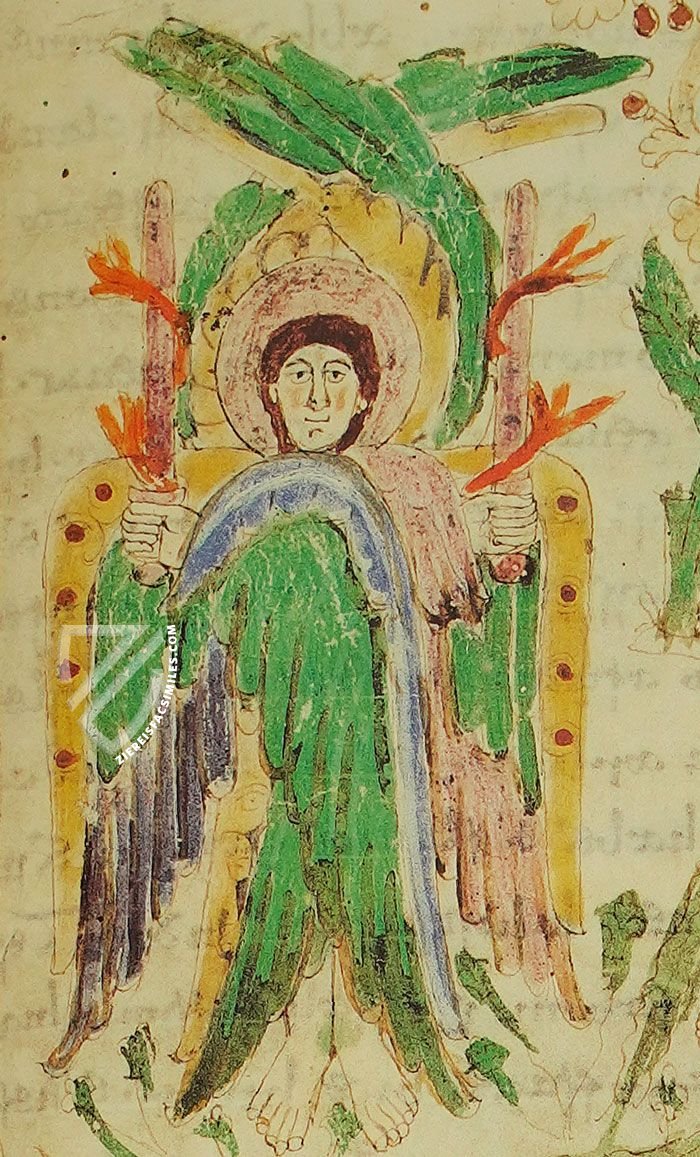
Hrabanus Maurus: De Universo - De Rerum Naturis
Beasts, Monsters, and Hybrids
Here we have a page from the bestiary section of this 11th century encyclopedia, which is filled with images of various creatures, all of whom were likely believed to be real at the time. The modern observer will immediately recognize that some of these animals are real, such as lions or other large cats, even if they are not always correctly colored, like the blue elephant.
Two of the large cats are depicted with multi-colored spots, possibly an unsuccessful attempt to portray a leopard or cheetah. At the top of the page, we see a large griffin with a pink body and blue wings. A small green hybrid can be seen at the bottom of the page, it has an uncolored human face and a body resembling that of a dog or possibly a lynx.
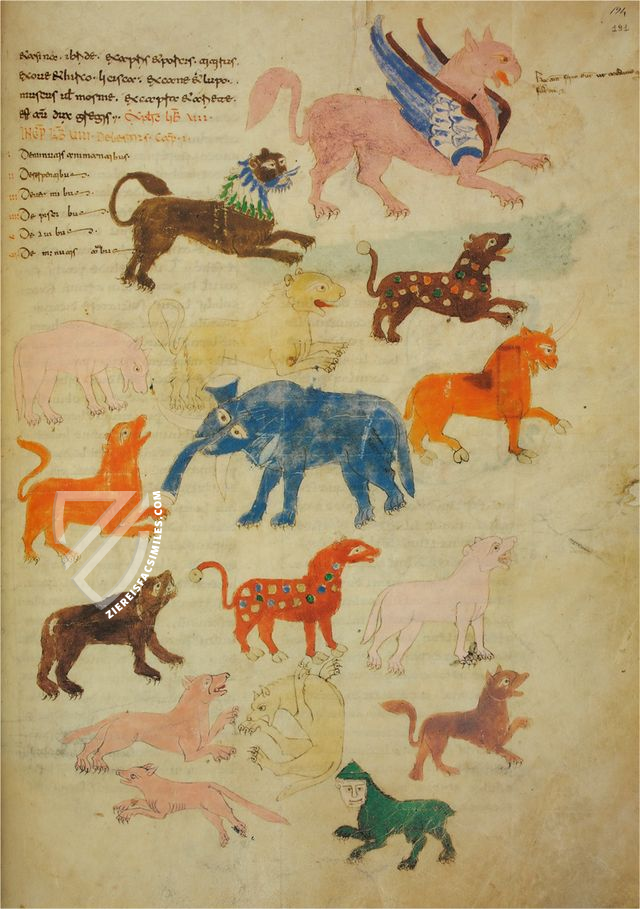
#1 De Universo De Rerum Naturis Rabano Mauro
Languages: Italian, English
(7,000€ - 10,000€)
- Treatises / Secular Books
- Apocalypses / Beatus
- Astronomy / Astrology
- Bestiaries
- Bibles / Gospels
- Chronicles / History / Law
- Geography / Maps
- Saints' Lives
- Islam / Oriental
- Judaism / Hebrew
- Single Leaf Collections
- Leonardo da Vinci
- Literature / Poetry
- Liturgical Manuscripts
- Medicine / Botany / Alchemy
- Music
- Mythology / Prophecies
- Psalters
- Other Religious Books
- Games / Hunting
- Private Devotion Books
- Other Genres
- Afghanistan
- Armenia
- Austria
- Belgium
- Belize
- Bosnia and Herzegovina
- China
- Colombia
- Costa Rica
- Croatia
- Cyprus
- Czech Republic
- Denmark
- Egypt
- El Salvador
- Ethiopia
- France
- Germany
- Greece
- Guatemala
- Honduras
- Hungary
- India
- Iran
- Iraq
- Israel
- Italy
- Japan
- Jordan
- Kazakhstan
- Kyrgyzstan
- Lebanon
- Liechtenstein
- Luxembourg
- Mexico
- Morocco
- Netherlands
- Palestine
- Panama
- Peru
- Poland
- Portugal
- Romania
- Russia
- Serbia
- Spain
- Sri Lanka
- Sweden
- Switzerland
- Syria
- Tajikistan
- Turkey
- Turkmenistan
- Ukraine
- United Kingdom
- United States
- Uzbekistan
- Vatican City
- A. Oosthoek, van Holkema & Warendorf
- Aboca Museum
- Ajuntament de Valencia
- Akademie Verlag
- Akademische Druck- u. Verlagsanstalt (ADEVA)
- Aldo Ausilio Editore - Bottega d’Erasmo
- Alecto Historical Editions
- Alkuin Verlag
- Almqvist & Wiksell
- Amilcare Pizzi
- Andreas & Andreas Verlagsbuchhandlung
- Archa 90
- Archiv Verlag
- Archivi Edizioni
- Arnold Verlag
- ARS
- Ars Magna
- ArtCodex
- AyN Ediciones
- Azimuth Editions
- Badenia Verlag
- Bärenreiter-Verlag
- Belser Verlag
- Belser Verlag / WK Wertkontor
- Benziger Verlag
- Bernardinum Wydawnictwo
- BiblioGemma
- Biblioteca Apostolica Vaticana (Vaticanstadt, Vaticanstadt)
- Bibliotheca Palatina Faksimile Verlag
- Bibliotheca Rara
- Boydell & Brewer
- Bramante Edizioni
- Bredius Genootschap
- Brepols Publishers
- British Library
- C. Weckesser
- Caixa Catalunya
- Canesi
- CAPSA, Ars Scriptoria
- Caratzas Brothers, Publishers
- Carus Verlag
- Casamassima Libri
- Centrum Cartographie Verlag GmbH
- Chavane Verlag
- Christian Brandstätter Verlag
- Circulo Cientifico
- Club Bibliófilo Versol
- Club du Livre
- CM Editores
- Collegium Graphicum
- Collezione Apocrifa Da Vinci
- Comissão Nacional para as Comemorações dos Descobrimentos Portugueses
- Coron Verlag
- Corvina
- CTHS
- D. S. Brewer
- Damon
- De Agostini/UTET
- De Nederlandsche Boekhandel
- De Schutter
- Deuschle & Stemmle
- Deutscher Verlag für Kunstwissenschaft
- DIAMM
- Droz
- E. Schreiber Graphische Kunstanstalten
- Ediciones Boreal
- Ediciones Grial
- Ediclube
- Edições Inapa
- Edilan
- Editalia
- Edition Deuschle
- Edition Georg Popp
- Edition Leipzig
- Edition Libri Illustri
- Editiones Reales Sitios S. L.
- Éditions de l'Oiseau Lyre
- Editions Medicina Rara
- Editorial Casariego
- Editorial Mintzoa
- Editrice Antenore
- Editrice Velar
- Edizioni Edison
- Egeria, S.L.
- Eikon Editores
- Electa
- Emery Walker Limited
- Enciclopèdia Catalana
- Eos-Verlag
- Ephesus Publishing
- Ernst Battenberg
- Eugrammia Press
- Extraordinary Editions
- Fackelverlag
- Facsimila Art & Edition
- Facsimile Editions Ltd.
- Facsimilia Art & Edition Ebert KG
- Faksimile Verlag
- Feuermann Verlag
- Folger Shakespeare Library
- Franco Cosimo Panini Editore
- Friedrich Wittig Verlag
- Fundación Hullera Vasco-Leonesa
- G. Braziller
- Gabriele Mazzotta Editore
- Gebr. Mann Verlag
- Gesellschaft für graphische Industrie
- Getty Research Institute
- Giovanni Domenico de Rossi
- Giunti Editore
- Graffiti
- Grafica European Center of Fine Arts
- Guido Pressler
- Guillermo Blazquez
- Gustav Kiepenheuer
- H. N. Abrams
- Harrassowitz
- Harvard University Press
- Helikon
- Hendrickson Publishers
- Henning Oppermann
- Herder Verlag
- Hes & De Graaf Publishers
- Hoepli
- Holbein-Verlag
- Houghton Library
- Hugo Schmidt Verlag
- Idion Verlag
- Il Bulino, edizioni d'arte
- ILte
- Imago
- Insel Verlag
- Insel-Verlag Anton Kippenberger
- Instituto de Estudios Altoaragoneses
- Instituto Nacional de Antropología e Historia
- Istituto dell'Enciclopedia Italiana - Treccani
- Istituto Ellenico di Studi Bizantini e Postbizantini
- Istituto Geografico De Agostini
- Istituto Poligrafico e Zecca dello Stato
- Italarte Art Establishments
- Jan Thorbecke Verlag
- Johnson Reprint Corporation
- Josef Stocker
- Josef Stocker-Schmid
- Jugoslavija
- Karl W. Hiersemann
- Kasper Straube
- Kaydeda Ediciones
- Kindler Verlag / Coron Verlag
- Kodansha International Ltd.
- Konrad Kölbl Verlag
- Kurt Wolff Verlag
- La Liberia dello Stato
- La Linea Editrice
- La Meta Editore
- Lambert Schneider
- Landeskreditbank Baden-Württemberg
- Leo S. Olschki
- Les Incunables
- Liber Artis
- Library of Congress
- Libreria Musicale Italiana
- Lichtdruck
- Lito Immagine Editore
- Lumen Artis
- Lund Humphries
- M. Moleiro Editor
- Maison des Sciences de l'homme et de la société de Poitiers
- Manuscriptum
- Martinus Nijhoff
- Maruzen-Yushodo Co. Ltd.
- MASA
- Massada Publishers
- McGraw-Hill
- Metropolitan Museum of Art
- Militos
- Millennium Liber
- Müller & Schindler
- Nahar - Stavit
- Nahar and Steimatzky
- National Library of Wales
- Neri Pozza
- Nova Charta
- Oceanum Verlag
- Odeon
- Orbis Mediaevalis
- Orbis Pictus
- Österreichische Staatsdruckerei
- Oxford University Press
- Pageant Books
- Parzellers Buchverlag
- Patrimonio Ediciones
- Pattloch Verlag
- PIAF
- Pieper Verlag
- Plon-Nourrit et cie
- Poligrafiche Bolis
- Presses Universitaires de Strasbourg
- Prestel Verlag
- Princeton University Press
- Prisma Verlag
- Priuli & Verlucca, editori
- Pro Sport Verlag
- Propyläen Verlag
- Pytheas Books
- Quaternio Verlag Luzern
- Reales Sitios
- Recht-Verlag
- Reichert Verlag
- Reichsdruckerei
- Reprint Verlag
- Riehn & Reusch
- Roberto Vattori Editore
- Rosenkilde and Bagger
- Roxburghe Club
- Salerno Editrice
- Saltellus Press
- Sandoz
- Sarajevo Svjetlost
- Schöck ArtPrint Kft.
- Schulsinger Brothers
- Scolar Press
- Scrinium
- Scripta Maneant
- Scriptorium
- Shazar
- Siloé, arte y bibliofilia
- SISMEL - Edizioni del Galluzzo
- Sociedad Mexicana de Antropología
- Société des Bibliophiles & Iconophiles de Belgique
- Soncin Publishing
- Sorli Ediciones
- Stainer and Bell
- Studer
- Styria Verlag
- Sumptibus Pragopress
- Szegedi Tudomànyegyetem
- Taberna Libraria
- Tarshish Books
- Taschen
- Tempus Libri
- Testimonio Compañía Editorial
- Thames and Hudson
- The Clear Vue Publishing Partnership Limited
- The Facsimile Codex
- The Folio Society
- The Marquess of Normanby
- The Richard III and Yorkist History Trust
- Tip.Le.Co
- TouchArt
- TREC Publishing House
- TRI Publishing Co.
- Trident Editore
- Tuliba Collection
- Typis Regiae Officinae Polygraphicae
- Union Verlag Berlin
- Universidad de Granada
- University of California Press
- University of Chicago Press
- Urs Graf
- Vallecchi
- Van Wijnen
- VCH, Acta Humaniora
- VDI Verlag
- VEB Deutscher Verlag für Musik
- Verlag Anton Pustet / Andreas Verlag
- Verlag Bibliophile Drucke Josef Stocker
- Verlag der Münchner Drucke
- Verlag für Regionalgeschichte
- Verlag Styria
- Vicent Garcia Editores
- W. Turnowski Ltd.
- W. Turnowsky
- Waanders Printers
- Wiener Mechitharisten-Congregation (Wien, Österreich)
- Wissenschaftliche Buchgesellschaft
- Wissenschaftliche Verlagsgesellschaft
- Wydawnictwo Dolnoslaskie
- Xuntanza Editorial
- Zakład Narodowy
- Zollikofer AG

